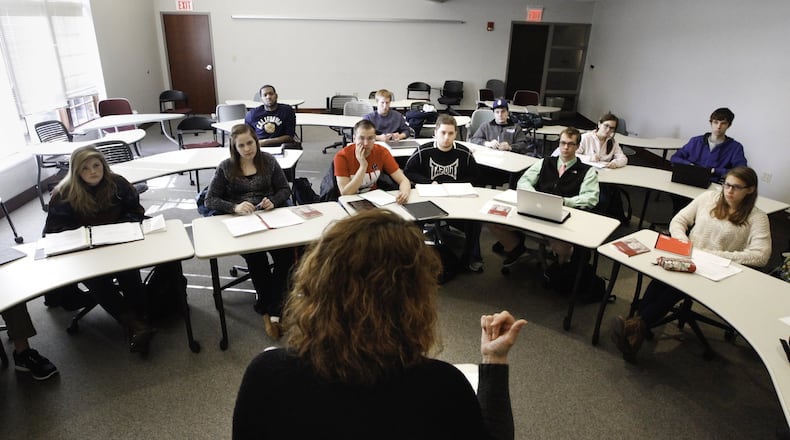The FAFSA calculates student-submitted family financial information to determine eligibility for federal grant, loan and work-study financial aid for college. In addition, the FAFSA is also a factor used by many colleges and private scholarship organizations to determine eligibility for their own financial aid.
Usually, families can start filling out the FAFSA in October for the following school year, but the delay in getting the revised form and new website up and running pushed back even this limited opening to Dec. 30. Many Ohio colleges and universities ask for the FAFSA to be filled out by Feb. 15 for priority consideration.
Some colleges and universities pushed back their deadlines to compensate for the late start. Wright State University pushed back the priority deadline to submit the FAFSA and scholarship materials to March 1. The University of Dayton kept the original Feb. 1 priority deadline for the FAFSA.
“Our stance has been that we want to provide support and complement federal and other resources available as the Simplified FAFSA is rolled out,” said Seth Bauguess, spokesman for Wright State.
It’s possible due to the delay that families could get financial aid packages later than normal.
Wright State’s Enrollment Services team can help Wright State families and students fill out the form, Bauguess noted.
The updated FAFSA form includes more languages available, more Pell Grant eligibility, fewer questions and the ability to list more colleges.
Ashley Overman, college access coordinator for Montgomery County Educational Service Center, said many families trying to access the portal are reporting getting a page that asks families to wait. Overman said it took her about four minutes to be moved off that page into a normal space, but some on social media have reported longer wait times in the past few days.
But Overman said it is worth it to continue to try to fill out the form, despite the challenges. The new FAFSA form is meant to be easier to fill out and includes expanded access for Pell Grants, which allow low-income students to attend college, to more than 600,000 people not previously eligible.
“Additionally, many colleges and universities have various financial aid deadlines where students can qualify for additional/larger scholarships if they meet the priority deadline,” Overman said.
The University of Dayton noted that many scholarships the university offers require the FAFSA to be completed.
What else is new in the FAFSA?
Part of the new launch includes updated Federal Student Aid IDs. Previously, only one FSA ID was needed, but now, it can take several days to create FSA IDs on studentaid.gov because the student and their contributors (parents, stepparents, guardians) each need one.
However, if you are a returning user, the FSA ID will remain the same.
Applicants can skip up to 26 questions, depending on their circumstances, and some applicants could answer as few as 18 questions, according to the U.S. Department of Education.
There are a few new terms on the form, according to the Montgomery County ESC.
* The Expected Family Contribution (EFC) will become the Student Aid Index (SAI).
*To transfer data from the IRS, use the DDX (Direct Data Exchange) instead of the DRT (Data Retrieval Tool).
* Anyone who is required to input data to the FAFSA will now be known as a “contributor” rather than “parent” or “student.”
* Finally, “family size” is replacing “household size” on the form.
Those are technical changes, but one of the biggest changes is more tangible. The new FAFSA does not make an adjustment for those students who have siblings in college. That means families with multiple college students should expect the SAI number (formerly expected family contribution) to increase.
FAFSA resources
The Montgomery County ESC is offering students and families help filling out the FAFSA. The next available dates are:
* New Lebanon Library: Friday, Jan. 5, 9:30 a.m. to noon;
* Trotwood Library: Friday, Jan. 5, 1-4 p.m.;
* Brookville Library: Monday, Jan. 8, 1-4 p.m.;
* West Branch Library (300 Abbey Ave., Dayton), Tuesday, Jan. 9, 3-7 p.m.;
* Wilmington-Stroop Library (3980 Wilmington Pike), Wednesday, Jan. 10, 4-6 p.m.;
* Electra C Doren Library (701 Troy St., Dayton), Wednesday, Jan. 17, 3 to 6 p.m.;
* Northwest Branch Library (2410 Philadelphia Dr., Dayton), Wednesday, Jan. 24, 3-6 p.m.;
* Vandalia Library, Monday, Feb. 5, 3-7 p.m.;
* West Carrollton Library, Tuesday, Feb. 6, 3-7 p.m.;
* Northmont Library, Wednesday, Feb. 7, 3-6 p.m.
* Burkhardt Library, Tuesday, Feb. 20, 3-7 p.m.
Virtual webinars have passed, but Overman is offering some availability outside those times. Email ashley.overman@mcesc.org for more information or fill out this form.
About the Author


